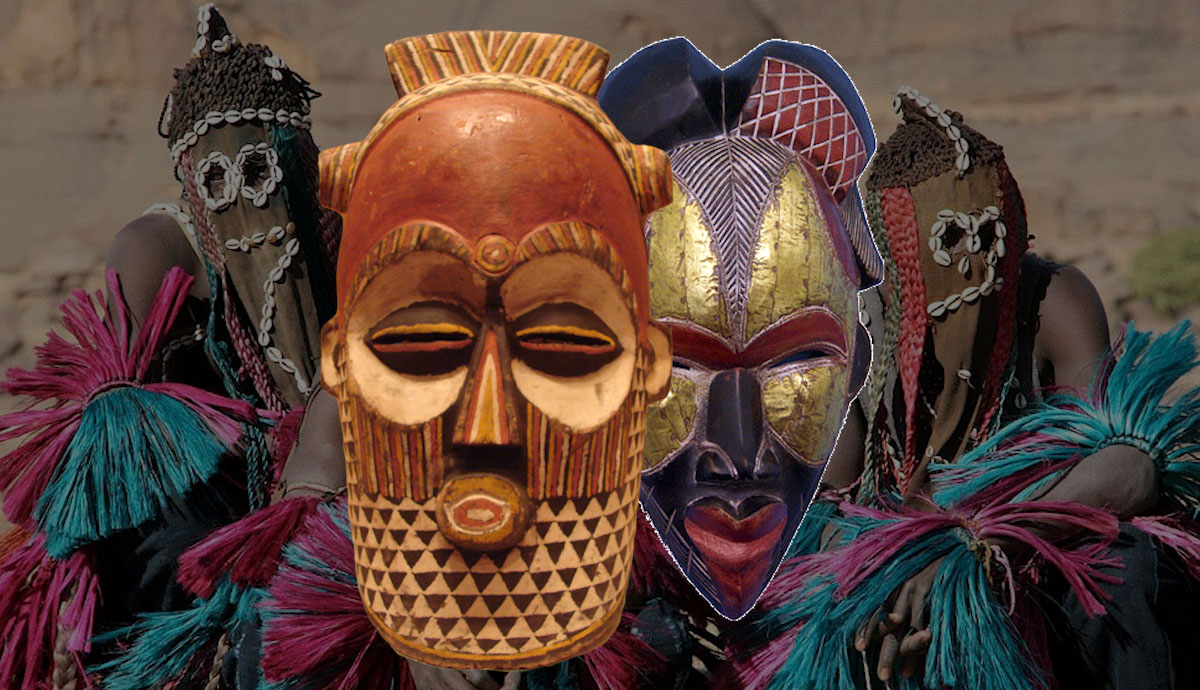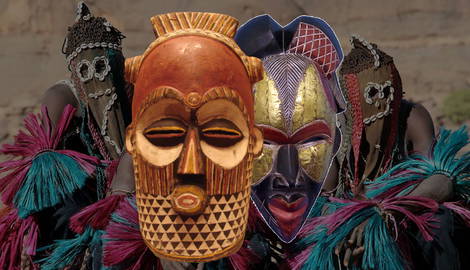
The artworks made by members of different African cultures were not only beautifully decorated, but carried many spiritual meanings. These intriguing creations featured intricate carvings, exaggerated forms, and symbols that carried a lot of weight for the cultures from various African regions. The stylistic and technical qualities of African masks have been applied to artworks across the Western world. It is safe to say that without the pieces created in Africa, Western art history would be vastly different.
African Masks: An Early Form of Abstraction

There was a period of time in Western art history when proper proportions, realism, and correct anatomy were of great importance, but African cultures that many modern artists took for inspiration valued different ideals. The style of African masks shows an interest in exaggerated facial features. This exaggeration created an almost surrealist or abstract version of what a human face could look like. Different regions in Africa would focus on different types of distortions that carried various meanings.
For example, the Pwo masks of the Chokwe people represented the gift of fertility and fruitfulness. Although worn by men, the exaggerated features such as the swollen eyes represented the pain of women during childbirth and the ultimate joy it brought. Nevertheless, the abstraction seen in these masks carried importance and it was accompanied by a long list of customs by which to abide. Modern artists that were inspired by African masks used the stylistic qualities of the pieces, but not their symbolic components.
Therefore, the distortion of human features seen in African masks traveled from Africa to Europe where artists adopted the aesthetic but rejected the spiritual importance that the pieces originally carried. For example, artists like Amadeo Modigliani used formal elements of the masks, like the thin, elongated nose as well as the shrunken, empty eyes. The types of masks Modigliani used for inspiration were characteristic of the Fang People culture, most notably of the Ngil members who served as judges and enforcers of the law. However, their original symbolism and political importance aren’t apparent to us when looking at a modern work of art.
African Tradition: Art That Symbolizes

African masks are not only a wonder from a formal standpoint, but they also carry significant weight as parts of a spiritual tradition. Many artists did not take this aspect of African masks into account when creating their pieces. However, some understood the importance of masks as cultural emblems too.
African masks were an integral part of African cultures across geographical locations. The Ngil people would use masks as a form of intimidation when enforcing the law, while other cultures sought to channel spirits during ceremonies and traditional events. In most cases, the masks symbolized power, spiritual connectedness, and various attributes of deities that were bestowed onto a member of a tribe. The masks were not only an intricate, delicately designed aspect of culture but also functioned as an essential part of a performance. It was important to use these masks to channel deities of various kinds that granted different prosperities to the people.
Some artists took this aspect of history into account when creating their pieces. For example, Wilfredo Lam sought to preserve African culture, as well as explore his own identity. As one of Cuban, Chinese, and Congolese descent, it was important for Lam to closely identify his roots and preserve cultural values. Using the aesthetic qualities of Cubism, Lam showed an African mask from multiple angles on the same picture plane while representing the traditions of his ancestors. Some artists did this in alignment with the cultural unrest in the Western World, most notably through the art of the Harlem Renaissance.
Establishing African Culture in America: The Harlem Renaissance

One of the most culturally significant movements in American art history is known as the Harlem Renaissance. In alignment with the Jim Crow Laws, it was more important than ever for African artists to display the culture from which they came. African American artists of all kinds, musicians, poets, and visual artists, came together to establish, showcase and unapologetically express their culture and tradition. Artists such as Jacob Lawrence and Aaron Douglas sought to convey the struggles of their American experience as well as revive the long-standing traditions of African art.
Artists of the Harlem Renaissance began incorporating many aspects of African culture through patterns, color choices, and popular motifs in their works. Another influential inclusion was that of African masks as a significant part of their iconography. Lois Mailou Jones was one of the artists who used African masks as an integral part of her works. Although she did not experience racial discrimination with such severity as many others did, the artist still did her best to remain under the radar. When asked why she included African motifs in her artworks, she replied: If masters like Matisse and Picasso can use them, don’t you think I should?
Technique: Reimagining the Mask

African masks have been included immensely as parts of the iconography in two-dimensional works, but sculptors have also used them as an inspiration in three-dimensional pieces. Many people understood the symbolism that masks carried in African cultures. They were used to assign jobs, performance in ceremonies, and channel spirits of specific types. Some contemporary artists took this type of usage and applied it to Western culture. In today’s society, we use masks every day for various reasons. For example, nurses and doctors wear masks to protect themselves from viruses, while firefighters wear gas masks to protect themselves from dangerous smoke fumes.
Lonnie Holley makes his artworks in order to comment on the applicability of masks in today’s society coupled with the African American experience. In his piece called African Mask, the use of a welder’s mask refers to African American men entering the industrial realm through low-earning and low-merit jobs. In contrast, African culture saw laborers, especially those that work with metals in a much better light. Because of this, Holley is able to transform this mask of American society into a transcendental and ceremonial image of notability. This also speaks of the importance of laborers in American culture. They are often disregarded while being absolutely essential to the economy.
Modern Artists: Paying Homage to African Masks

Throughout modern art history, artists have used African masks as the source of their inspiration for a variety of reasons. Artists of the 1910s in Europe used the abstract facial features of masks in their works, while those of the 1920s used the masks as a method of establishing a new subculture of Americans through the Harlem Renaissance.
Modern artists like Jean Michel Basquiat were also inspired by African masks. Basquiat is known for his contrasting color choices, intriguing iconography, and the inclusion of words to add emphasis to his ideas. When looking at the image shown above, it is clear that Basquiat got inspiration from African art of the past, keeping the spirit of primitive art and adding a modern flare.










